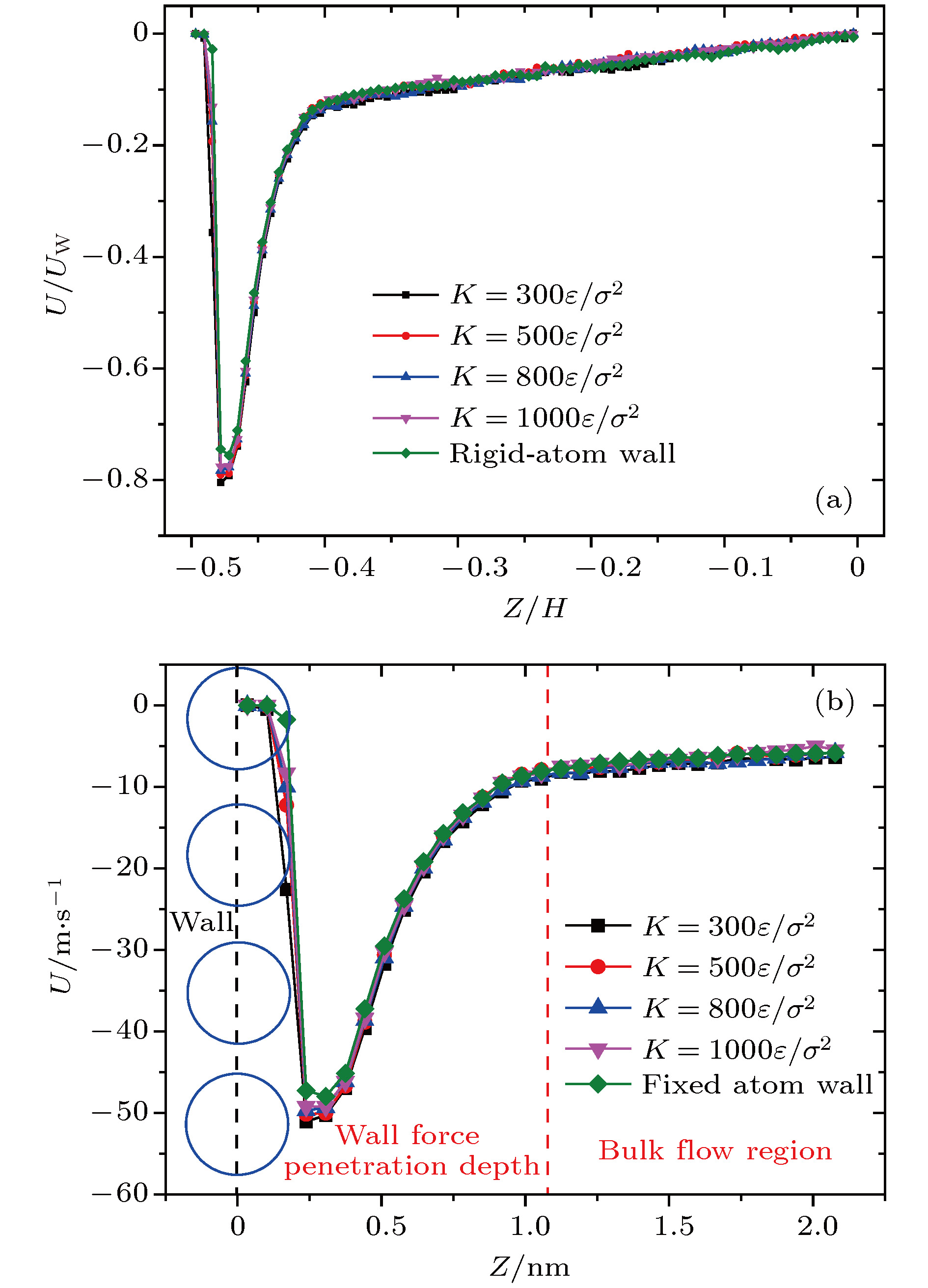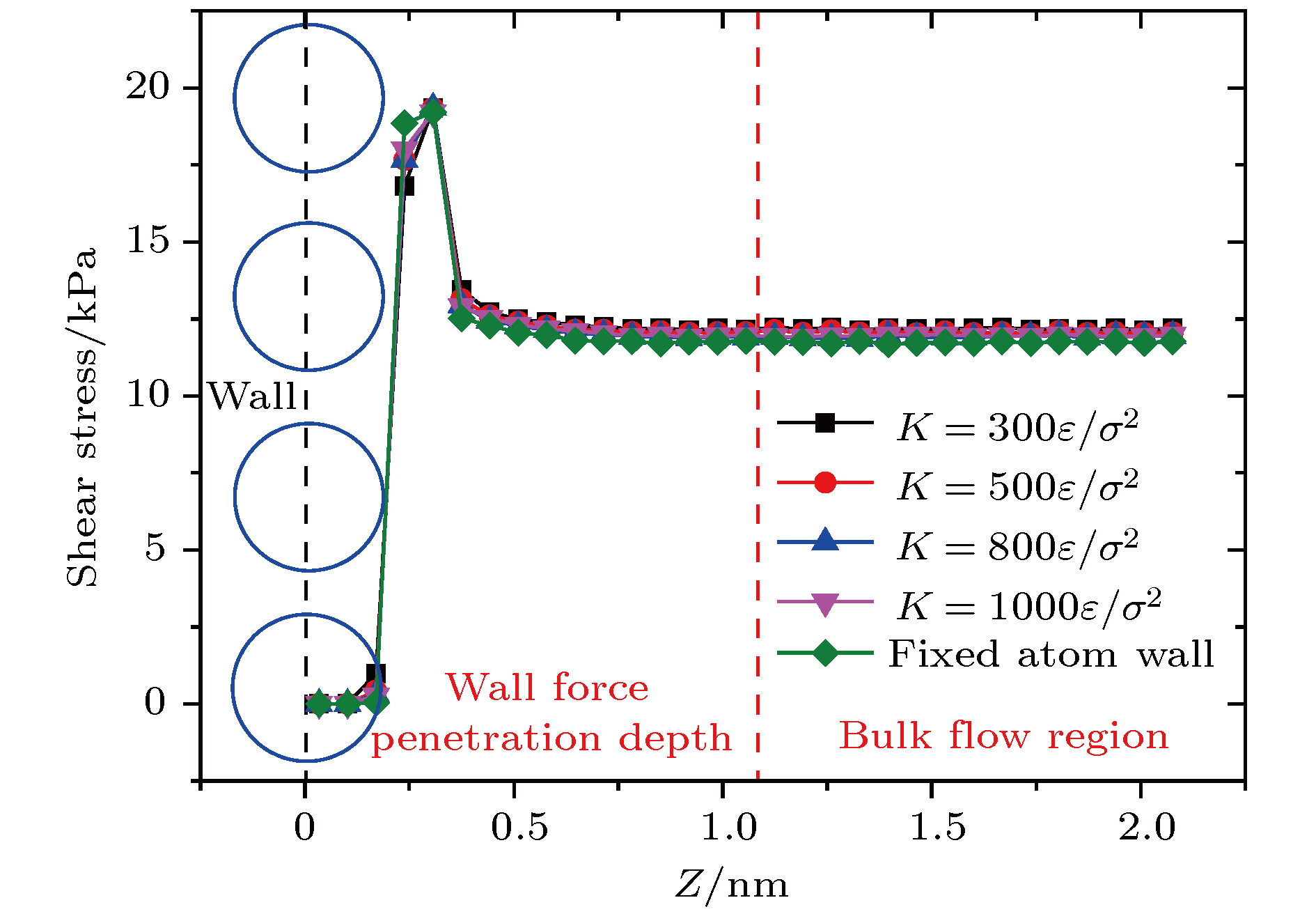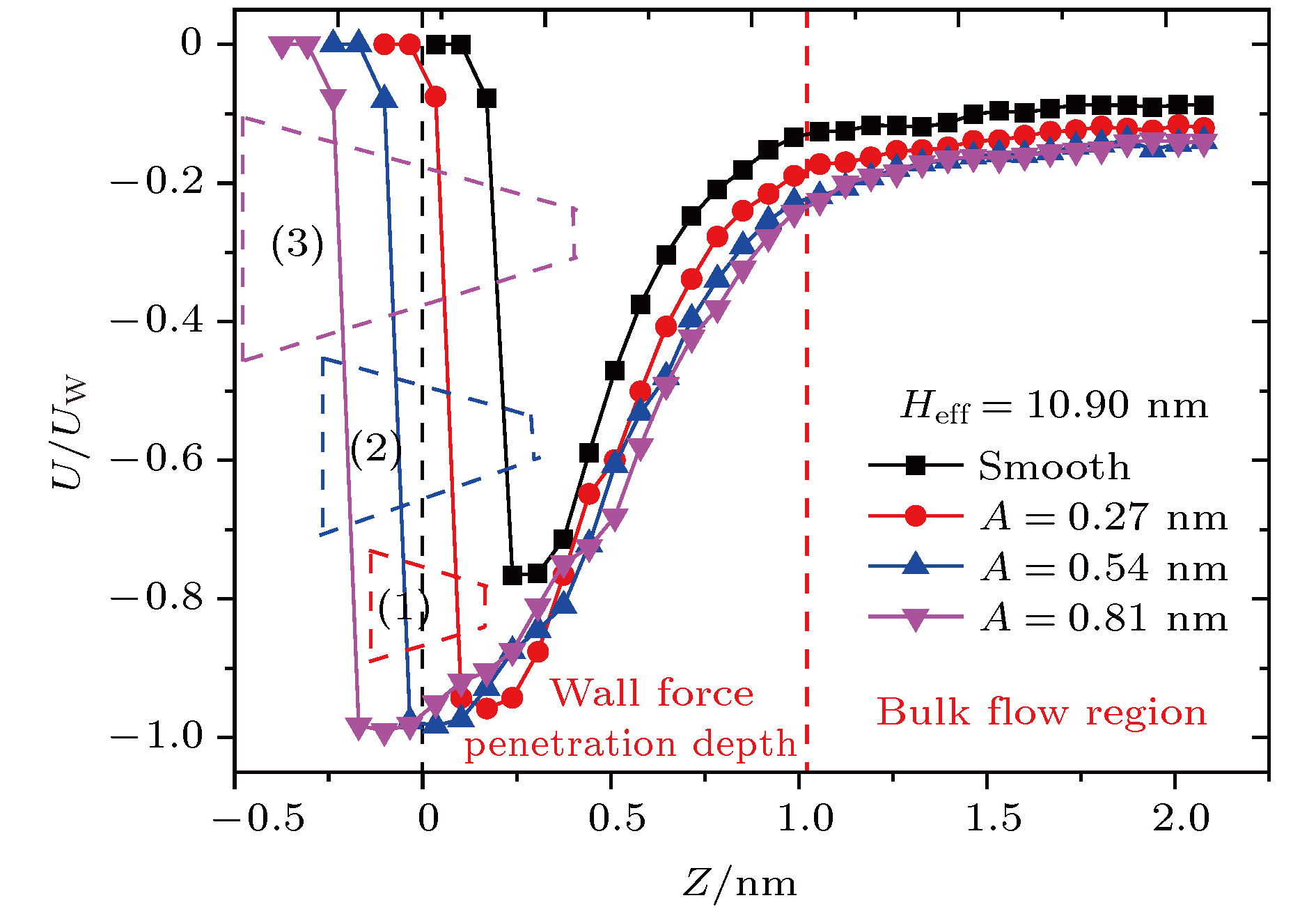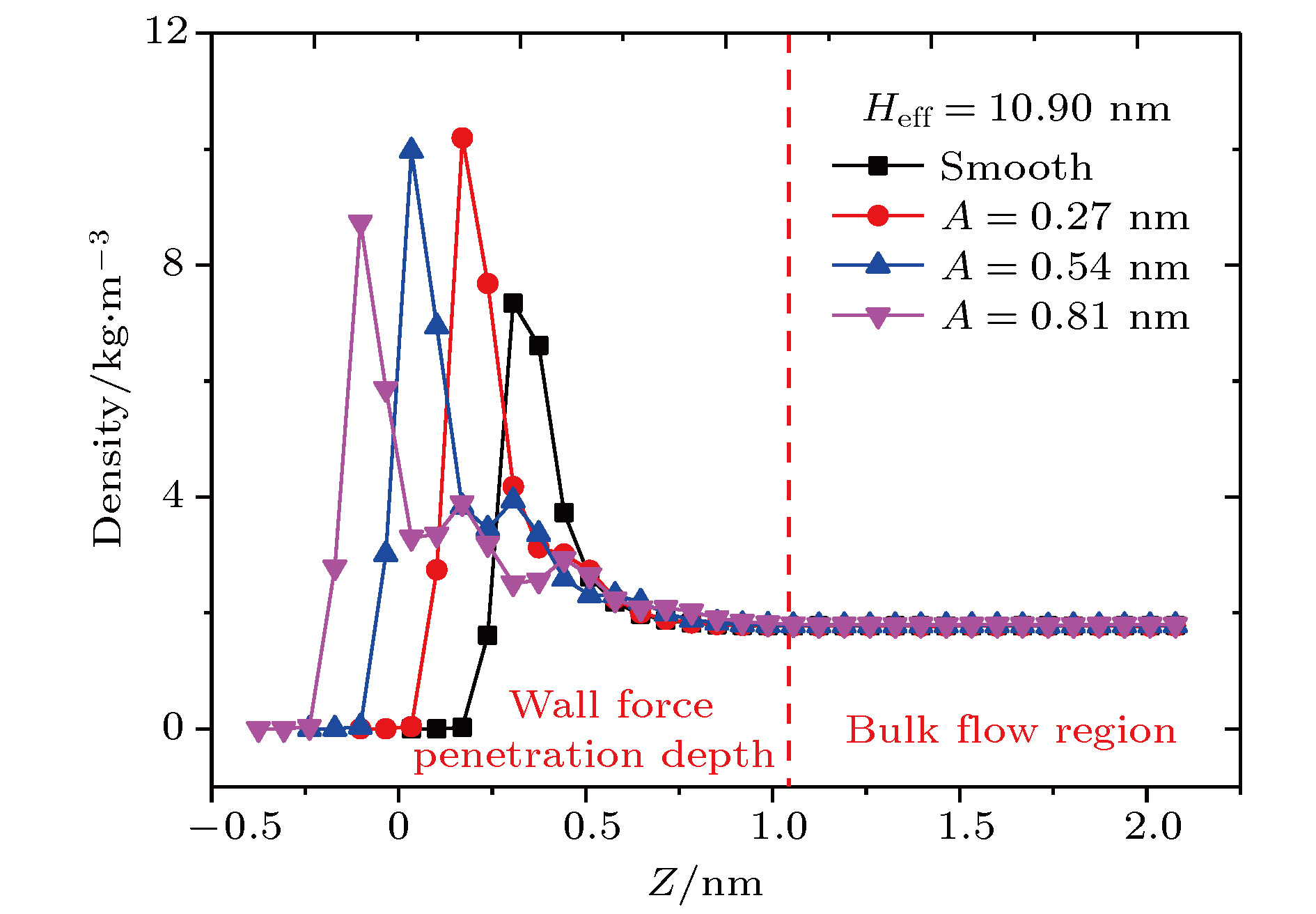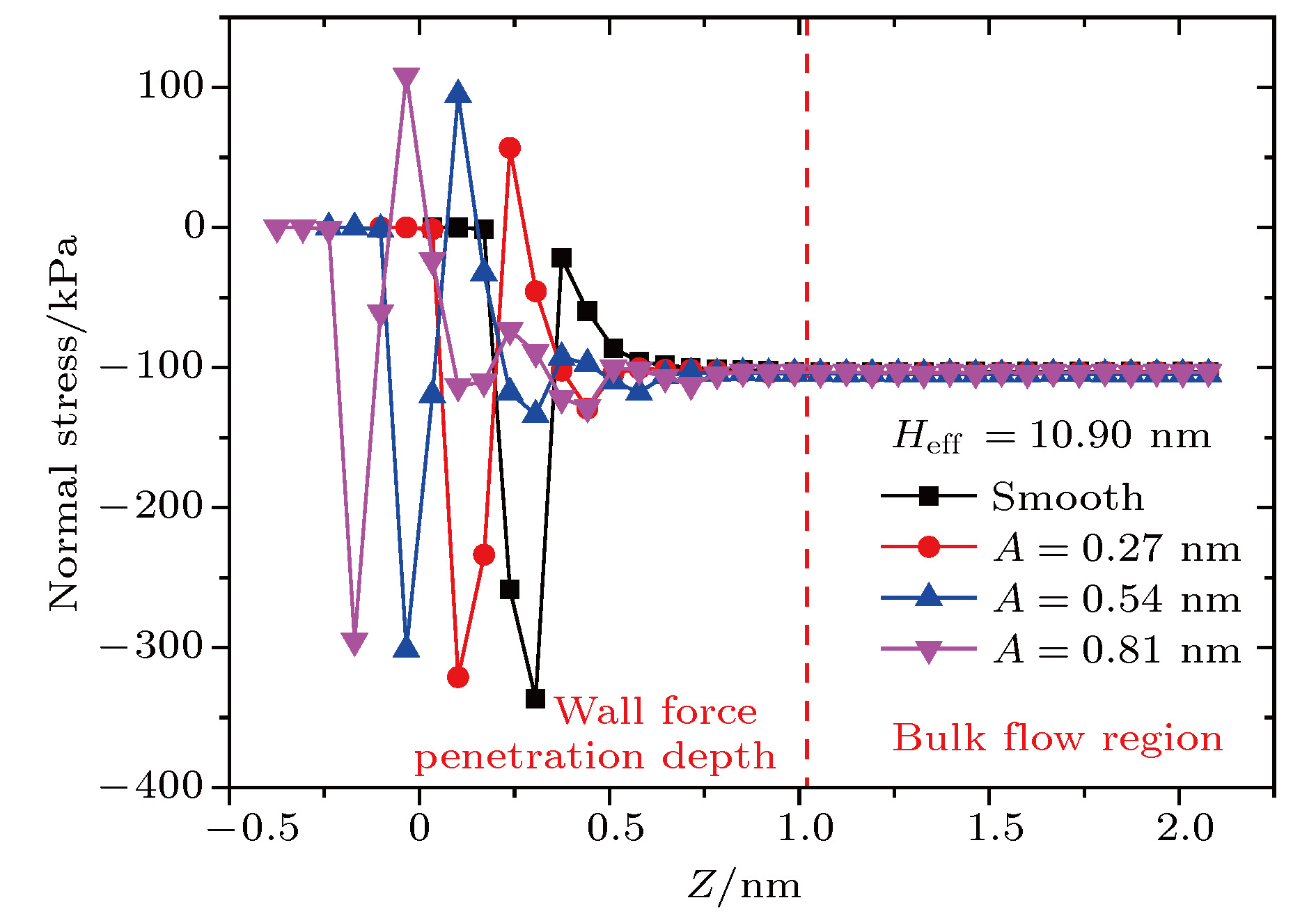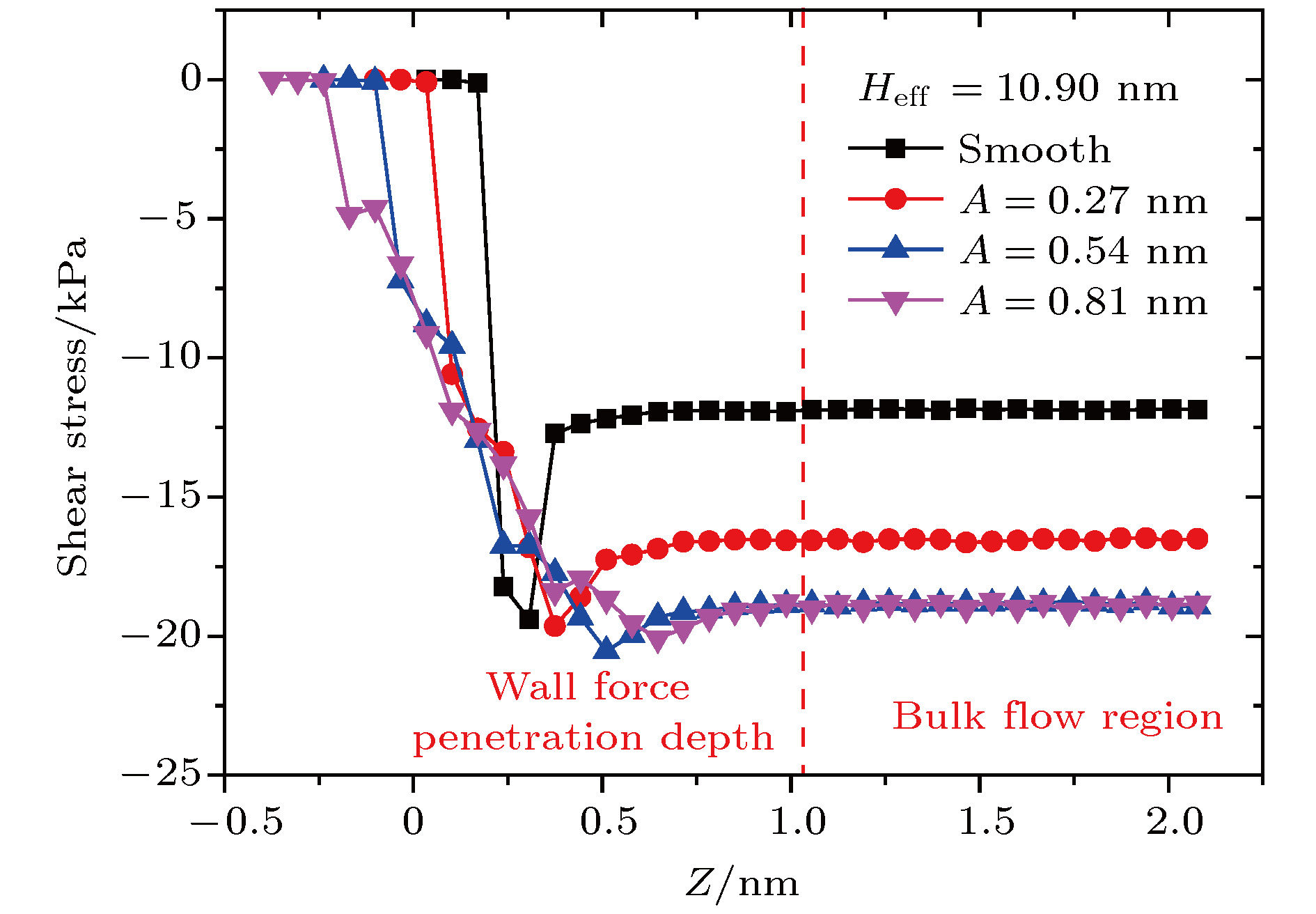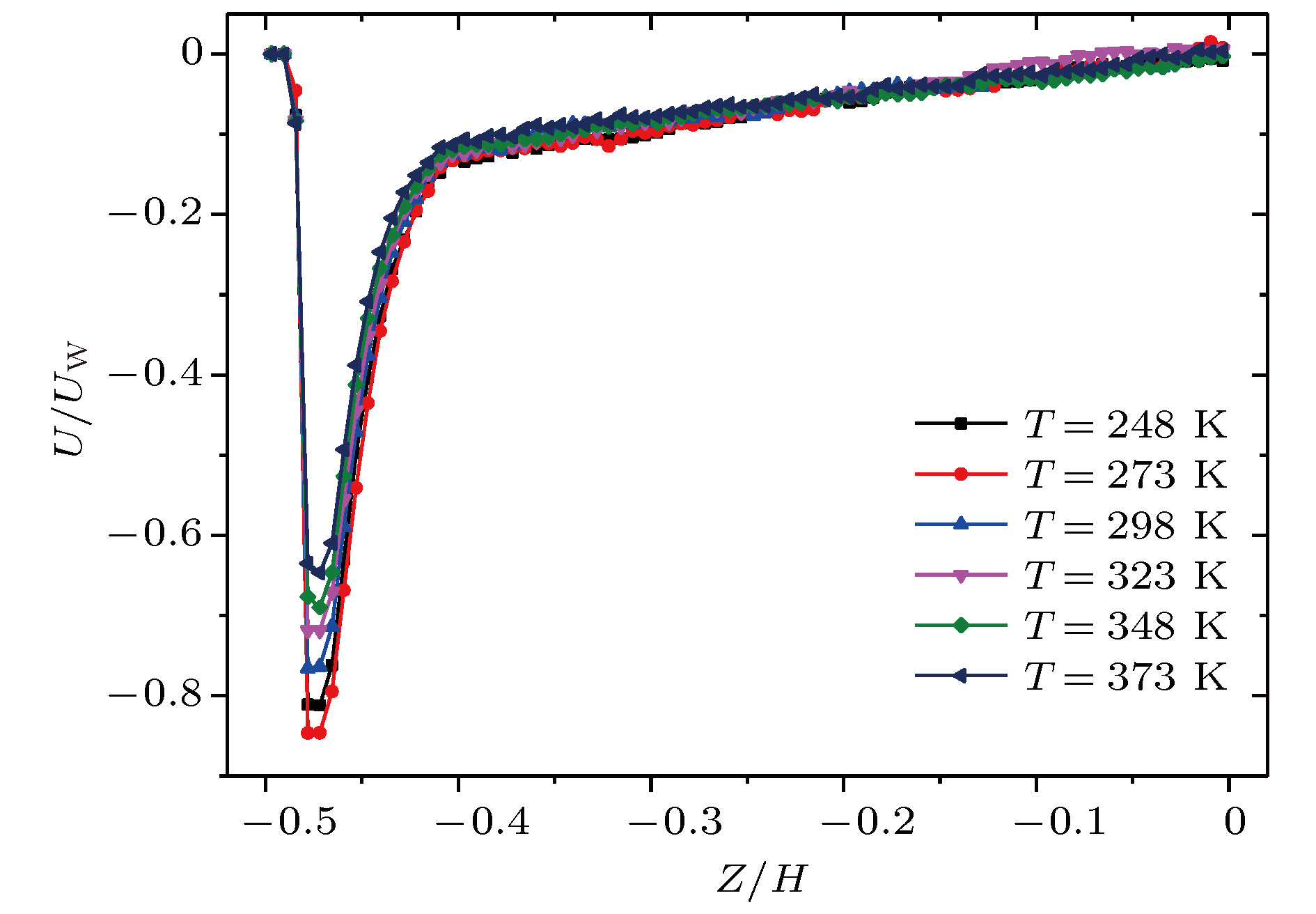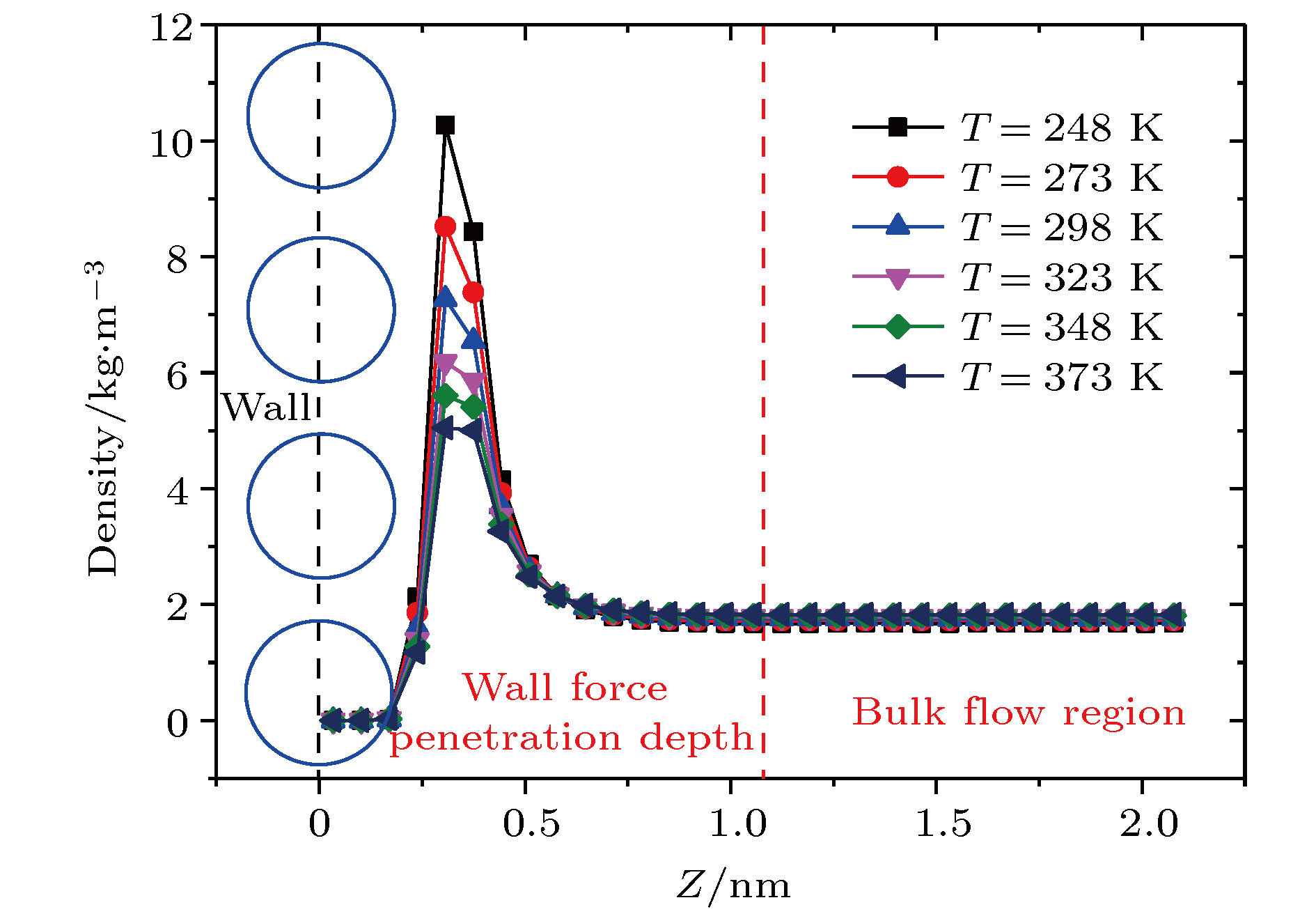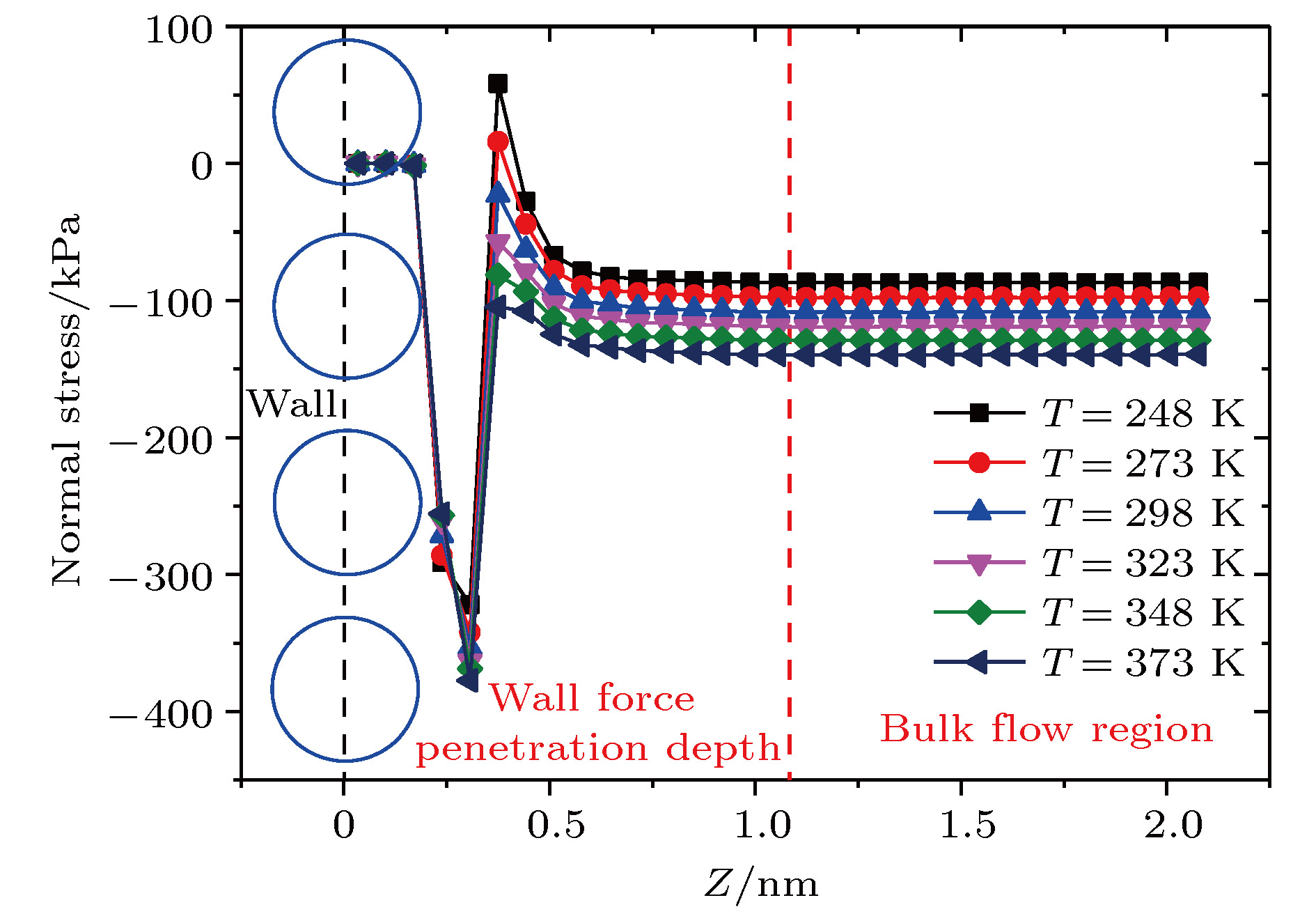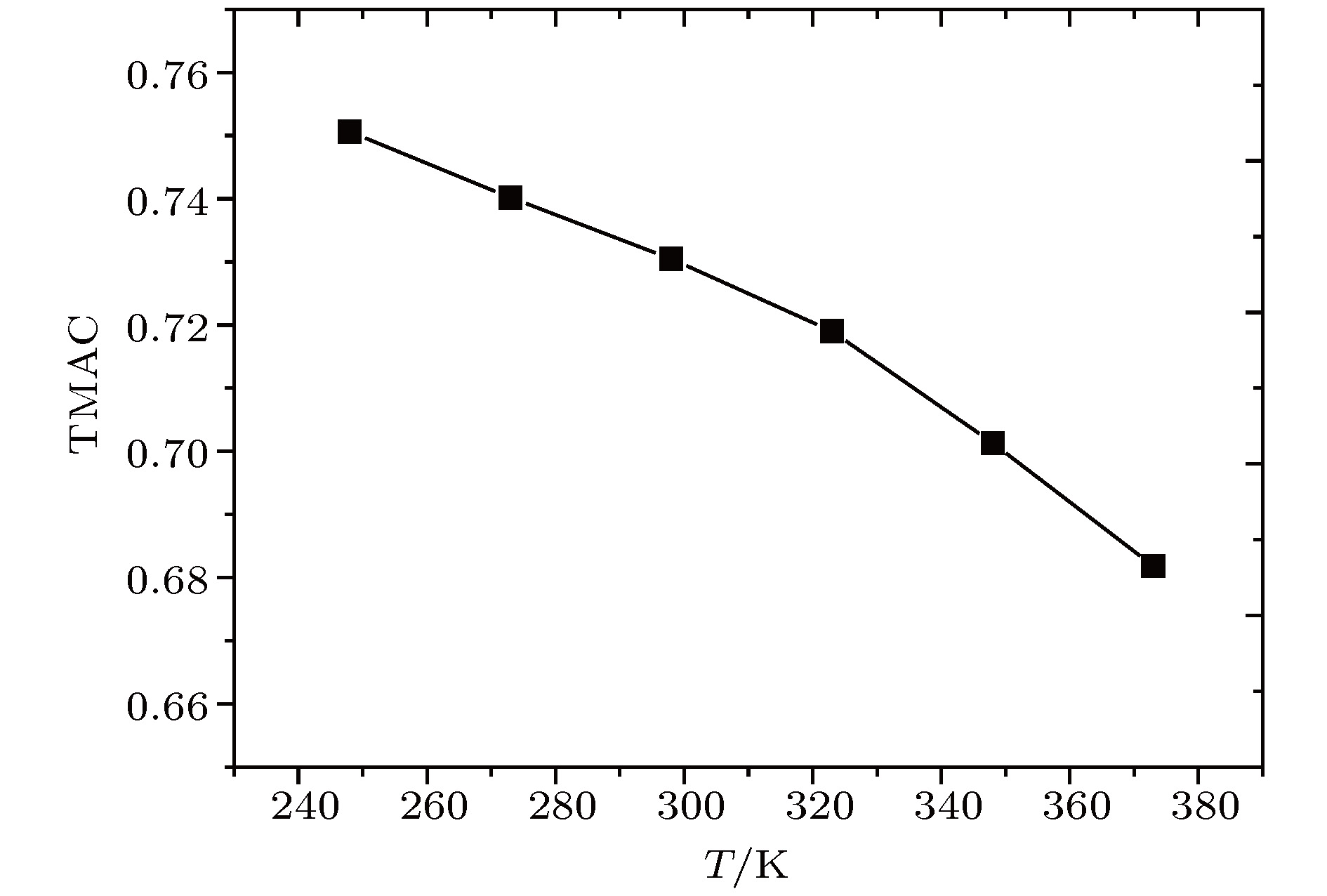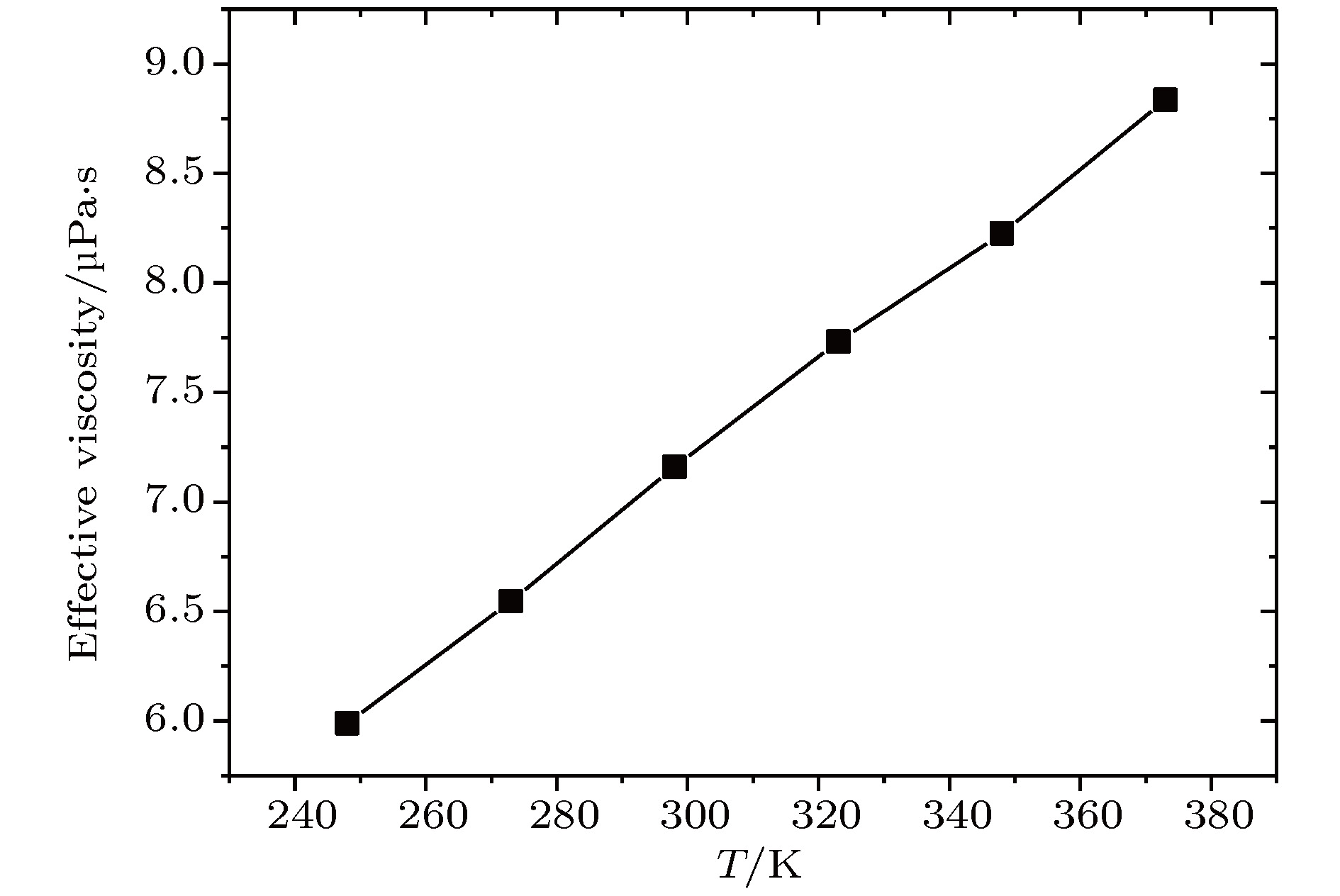-
A three-dimensional non-equilibrium molecular dynamics method is adopted to investigate the influence of wall force field on the nanoscale gas flow in the transition regime. For the gas flow under nanoscale condition, the dominant effect of the wall force field on the flow field is more obvious, and the flow physical quantity is more sensitive to the change of the wall condition and system temperature. The motion of the wall atoms is governed by the Einstein theory, with using an elastic coefficient k to model the surface stiffness. The results indicate that the surface stiffness has little effect on the physical quantity distribution of the bulk flow region, but a certain influence on that of the near wall region. Increasing the value of the stiffness changes the velocity peak of the gas in the near-wall region and the tangential momentum adaptation coefficient (TMAC) towards lower values, thus demoting the momentum adaptability of the gas molecules to the surface. The wall roughness is simulated by a typical pyramidal model. It is found that the influence of wall roughness on the flow is very obvious, whether it is in the bulk flow region or in the near wall region. For the former case, the increase of roughness leads gas velocity and shear stress to increase, with density and normal stress remaining constant. The linear distribution of physical quantities is also affected to some extent. While for the latter case, as the roughness increases, the velocity of the fluid increases rapidly and approaches to the wall velocity. The peak of density increases, and the adsorption of gas molecules at the surface is obvious. The TMAC approaches to 1, suggesting that the gas and the surface achieve a complete momentum adaptation. Besides, the influence of system temperature on the gas flow in the nanochannel is also studied. The system temperature is controlled by the Nose-Hoover thermostat, making the flow field maintained at the target temperature through the damping coefficient. The results show that the effect of temperature is global in the whole flow region. The increase of temperature causes the flow velocity of the whole flow field to decrease, while the normal stress and shear stress to increase. A higher temperature leads to more frequent collisions between gas molecules, thus increasing the effective viscosity of the gas. At the same time, the degree of gas molecule adsorption in the near-wall region is reduced, contributing to a smaller TMAC value, and consequently a weaker gas-surface interaction.
-
Keywords:
- nanoscale gas flow /
- wall force effects /
- tangential momentum accommodation coefficient /
- shear stress
[1] Verbridge S S, Craighead H G, Parpia J M 2008 Appl. Phys. Lett. 92 013112
 Google Scholar
Google Scholar
[2] Cao B Y, Sun J, Chen M, Guo Z Y 2009 Int. J. Mol. Sci. 10 4638
 Google Scholar
Google Scholar
[3] Boettcher U, Li H, Callafon R A, Talke F E 2011 IEEE Trans. Magn. 47 1823
 Google Scholar
Google Scholar
[4] Song H Q, Yu M X, Zhu W Y, Zhang Y, Jiang S X 2013 Chin. Phys. Lett. 30 014701
 Google Scholar
Google Scholar
[5] Zhang W, Meng G, Wei X 2012 Microfluid. Nanofluid. 13 845
 Google Scholar
Google Scholar
[6] Maxwell J C 1879 Phil. Trans. R. Soc. Lond. 170 231
 Google Scholar
Google Scholar
[7] Sharipov F, Kalempa D 2004 Phys. Fluids 16 3779
 Google Scholar
Google Scholar
[8] Zhang Z Q, Zhang H W, Ye H F 2009 Appl. Phys. Lett. 95 154101
 Google Scholar
Google Scholar
[9] Zhang H W, Zhang Z Q, Zheng Y G, Ye H F 2010 Phys. Rev. E 81 066303
 Google Scholar
Google Scholar
[10] Bird G A 1994 Molecular Gas Dynamics and the Direct Simulation of Gas Flows (Oxford: Oxford University Press) pp199−206
[11] Fan J, Shen C 2001 J. Comput. Phys. 167 393
 Google Scholar
Google Scholar
[12] Rapaport D C 2004 The Art of Molecular Dynamics Simulation (New York: Cambridge University Press) pp4, 5
[13] 曹炳阳, 陈民, 过增元 2006 55 5305
 Google Scholar
Google Scholar
Cao B Y, Chen M, Guo Z Y 2006 Acta Phys. Sin. 55 5305
 Google Scholar
Google Scholar
[14] Cao B Y 2007 Mol. Phys. 105 1403
 Google Scholar
Google Scholar
[15] Priezjev N V 2011 J. Chem. Phys. 135 204704
 Google Scholar
Google Scholar
[16] Sun J, Li Z X 2008 Mol. Phys. 106 2325
 Google Scholar
Google Scholar
[17] Spijker P, Markvoort A J, Nedea S V, Hilbers P A 2010 Phys. Rev. E 81 011203
 Google Scholar
Google Scholar
[18] Xie H, Liu C 2011 Mod. Phys. Lett. B 25 773
 Google Scholar
Google Scholar
[19] Kamali R, Kharazmi A 2011 Int. J. Therm. Sci. 50 226
 Google Scholar
Google Scholar
[20] Barisik M, Beskok A 2011 Microfluid. Nanofluid. 11 611
 Google Scholar
Google Scholar
[21] Barisik M, Beskok A 2012 Microfluid. Nanofluid. 13 789
 Google Scholar
Google Scholar
[22] Noorian H, Toghraie D, Azimian A R 2014 Heat Mass Transfer 50 105
 Google Scholar
Google Scholar
[23] Bao F B, Huang Y L, Qiu L M, Lin J Z 2015 Mol. Phys. 113 561
 Google Scholar
Google Scholar
[24] Bao F B, Huang Y L, Zhang Y H, Lin J Z 2015 Microfluid. Nanofluid. 18 1075
 Google Scholar
Google Scholar
[25] To Q D, Leonard C, Lauriat G 2015 Phys. Rev. E 91 023015
 Google Scholar
Google Scholar
[26] Liakopoulos A, Sofos F, Karakasidis T E 2016 Microfluid. Nanofluid. 20 24
 Google Scholar
Google Scholar
[27] Lim W W, Suaning G J, McKenzie D R 2016 Phys. Fluids 28 097101
 Google Scholar
Google Scholar
[28] 王胜, 徐进良, 张龙艳 2017 66 204704
 Google Scholar
Google Scholar
Wang S, Xu J L, Zhang L Y 2017 Acta Phys. Sin. 66 204704
 Google Scholar
Google Scholar
[29] 张冉, 谢文佳, 常青, 李桦 2018 67 084701
 Google Scholar
Google Scholar
Zhang R, Xie W J, Chang Q, Li H 2018 Acta Phys. Sin. 67 084701
 Google Scholar
Google Scholar
[30] Hook J R, Hall H E 1991 Solid State Physics (Chichester: Wiley) pp96−106
[31] Priezjev N V 2007 J. Chem. Phys. 127 144708
 Google Scholar
Google Scholar
[32] Asproulis N, Drikakis D 2010 Phys. Rev. E 81 061503
 Google Scholar
Google Scholar
[33] Asproulis N 2011 Phys. Rev. E 84 031504
 Google Scholar
Google Scholar
[34] Wu L, Bogy D B 2002 J. Tribol.-T. ASME 124 562
 Google Scholar
Google Scholar
[35] Cao B Y, Chen M, Guo Z Y 2005 Appl. Phys. Lett. 86 091905
 Google Scholar
Google Scholar
[36] Cieplak M, Koplik J, Banavar J R 2001 Phys. Rev. Lett. 86 803
 Google Scholar
Google Scholar
[37] 张冉, 常青, 李桦 2018 67 223401
 Google Scholar
Google Scholar
Zhang R, Chang Q, Li H 2018 Acta Phys. Sin. 67 223401
 Google Scholar
Google Scholar
[38] Evans D J, Hoover W G 1986 Annu. Rev. Fluid Mech. 18 243
 Google Scholar
Google Scholar
[39] Fukui S, Shimada H, Yamane K, Matsuoka H 2005 Microsyst. Technol. 11 805
 Google Scholar
Google Scholar
[40] Bahukudumbi P, Park J H, Beskok A 2003 Microscale Thermophy. Eng. 7 291
 Google Scholar
Google Scholar
-
表 1 计算条件设置
Table 1. Parameters of the study on the influences of surface stiffness, roughness and temperature.
研究目的 $\rho /{\rm{kg}} \cdot {{\rm{m}}^{ - {\rm{3}}}}$ $H/{\rm{nm}}$ ${L_X}/{\rm{nm}}$ ${L_Y}/{\rm{nm}}$ 参数设置 弹性系数影响 1.86 10.89 65.38 65.38 $K/\varepsilon \cdot {\sigma ^{ - 2}}=300,\;500,\;800,\;1000,\;\infty $ 粗糙度影响 1.86 10.89 65.38 65.38 ${H_{{\rm{roughness}}}}=0.27, 0.54, 0.81\;{\rm{nm}}$ 温度影响 1.86 10.89 65.38 65.38 $T=248, 273, 298, 323, 348, 373\;{\rm{K}}$ 表 2 不同壁面弹性系数条件下纳米通道中的剪切应力及TMAC大小
Table 2. Shear stress and TMAC values with different surface stiffness.
$K/\varepsilon \cdot {\sigma ^{ - 2}}$ ${\rho _{{\rm{Bulk}}}}/{\rm{kg}} \cdot {{\rm{m}}^{ - 3}}$ $\lambda /{\rm{nm}}$ $H/{\rm{nm}}$ $Kn$ ${\tau _{{\rm{Theo}},\sigma = 1.0}}/{\rm{kPa}}$ ${\tau _{{\rm{MD}}}}/{\rm{kPa}}$ TMAC 300 1.76 65.00 10.90 5.96 19.88 12.19 0.750 500 1.76 65.00 10.90 5.96 19.86 12.07 0.746 800 1.76 64.95 10.90 5.96 19.89 11.95 0.741 1000 1.76 64.98 10.90 5.96 19.88 11.96 0.741 $ \infty$ 1.76 64.72 10.90 5.96 19.95 11.75 0.736 表 3 不同温度条件下主流区域正应力与理论值对比
Table 3. Comparisons of normal stress with its theoretic values in bulk flow under different temperature conditions.
T/K ${{\rho }_{\rm{Bulk}}}/\rm{kg}\cdot {{\rm{m}}^{-{\rm{3}}}}$ ${s_{xx}}/{\rm{kPa}}$ ${s_{yy}}/{\rm{kPa}}$ ${s_{zz}}/{\rm{kPa}}$ ${P_{{\rm{MD}}}}/{\rm{kPa}}$ ${P_{{\rm{Theo}}}}/{\rm{kPa}}$ Error/% 248 1.69 87.97 84.88 87.11 86.65 87.00 0.40 273 1.73 98.99 95.38 97.89 97.56 98.26 0.71 298 1.76 109.54 106.01 108.97 108.48 109.41 0.85 323 1.80 120.26 116.97 119.68 118.72 120.93 1.83 348 1.82 130.32 127.12 129.69 128.99 131.79 2.13 373 1.83 140.44 137.23 140.28 139.43 142.43 2.11 -
[1] Verbridge S S, Craighead H G, Parpia J M 2008 Appl. Phys. Lett. 92 013112
 Google Scholar
Google Scholar
[2] Cao B Y, Sun J, Chen M, Guo Z Y 2009 Int. J. Mol. Sci. 10 4638
 Google Scholar
Google Scholar
[3] Boettcher U, Li H, Callafon R A, Talke F E 2011 IEEE Trans. Magn. 47 1823
 Google Scholar
Google Scholar
[4] Song H Q, Yu M X, Zhu W Y, Zhang Y, Jiang S X 2013 Chin. Phys. Lett. 30 014701
 Google Scholar
Google Scholar
[5] Zhang W, Meng G, Wei X 2012 Microfluid. Nanofluid. 13 845
 Google Scholar
Google Scholar
[6] Maxwell J C 1879 Phil. Trans. R. Soc. Lond. 170 231
 Google Scholar
Google Scholar
[7] Sharipov F, Kalempa D 2004 Phys. Fluids 16 3779
 Google Scholar
Google Scholar
[8] Zhang Z Q, Zhang H W, Ye H F 2009 Appl. Phys. Lett. 95 154101
 Google Scholar
Google Scholar
[9] Zhang H W, Zhang Z Q, Zheng Y G, Ye H F 2010 Phys. Rev. E 81 066303
 Google Scholar
Google Scholar
[10] Bird G A 1994 Molecular Gas Dynamics and the Direct Simulation of Gas Flows (Oxford: Oxford University Press) pp199−206
[11] Fan J, Shen C 2001 J. Comput. Phys. 167 393
 Google Scholar
Google Scholar
[12] Rapaport D C 2004 The Art of Molecular Dynamics Simulation (New York: Cambridge University Press) pp4, 5
[13] 曹炳阳, 陈民, 过增元 2006 55 5305
 Google Scholar
Google Scholar
Cao B Y, Chen M, Guo Z Y 2006 Acta Phys. Sin. 55 5305
 Google Scholar
Google Scholar
[14] Cao B Y 2007 Mol. Phys. 105 1403
 Google Scholar
Google Scholar
[15] Priezjev N V 2011 J. Chem. Phys. 135 204704
 Google Scholar
Google Scholar
[16] Sun J, Li Z X 2008 Mol. Phys. 106 2325
 Google Scholar
Google Scholar
[17] Spijker P, Markvoort A J, Nedea S V, Hilbers P A 2010 Phys. Rev. E 81 011203
 Google Scholar
Google Scholar
[18] Xie H, Liu C 2011 Mod. Phys. Lett. B 25 773
 Google Scholar
Google Scholar
[19] Kamali R, Kharazmi A 2011 Int. J. Therm. Sci. 50 226
 Google Scholar
Google Scholar
[20] Barisik M, Beskok A 2011 Microfluid. Nanofluid. 11 611
 Google Scholar
Google Scholar
[21] Barisik M, Beskok A 2012 Microfluid. Nanofluid. 13 789
 Google Scholar
Google Scholar
[22] Noorian H, Toghraie D, Azimian A R 2014 Heat Mass Transfer 50 105
 Google Scholar
Google Scholar
[23] Bao F B, Huang Y L, Qiu L M, Lin J Z 2015 Mol. Phys. 113 561
 Google Scholar
Google Scholar
[24] Bao F B, Huang Y L, Zhang Y H, Lin J Z 2015 Microfluid. Nanofluid. 18 1075
 Google Scholar
Google Scholar
[25] To Q D, Leonard C, Lauriat G 2015 Phys. Rev. E 91 023015
 Google Scholar
Google Scholar
[26] Liakopoulos A, Sofos F, Karakasidis T E 2016 Microfluid. Nanofluid. 20 24
 Google Scholar
Google Scholar
[27] Lim W W, Suaning G J, McKenzie D R 2016 Phys. Fluids 28 097101
 Google Scholar
Google Scholar
[28] 王胜, 徐进良, 张龙艳 2017 66 204704
 Google Scholar
Google Scholar
Wang S, Xu J L, Zhang L Y 2017 Acta Phys. Sin. 66 204704
 Google Scholar
Google Scholar
[29] 张冉, 谢文佳, 常青, 李桦 2018 67 084701
 Google Scholar
Google Scholar
Zhang R, Xie W J, Chang Q, Li H 2018 Acta Phys. Sin. 67 084701
 Google Scholar
Google Scholar
[30] Hook J R, Hall H E 1991 Solid State Physics (Chichester: Wiley) pp96−106
[31] Priezjev N V 2007 J. Chem. Phys. 127 144708
 Google Scholar
Google Scholar
[32] Asproulis N, Drikakis D 2010 Phys. Rev. E 81 061503
 Google Scholar
Google Scholar
[33] Asproulis N 2011 Phys. Rev. E 84 031504
 Google Scholar
Google Scholar
[34] Wu L, Bogy D B 2002 J. Tribol.-T. ASME 124 562
 Google Scholar
Google Scholar
[35] Cao B Y, Chen M, Guo Z Y 2005 Appl. Phys. Lett. 86 091905
 Google Scholar
Google Scholar
[36] Cieplak M, Koplik J, Banavar J R 2001 Phys. Rev. Lett. 86 803
 Google Scholar
Google Scholar
[37] 张冉, 常青, 李桦 2018 67 223401
 Google Scholar
Google Scholar
Zhang R, Chang Q, Li H 2018 Acta Phys. Sin. 67 223401
 Google Scholar
Google Scholar
[38] Evans D J, Hoover W G 1986 Annu. Rev. Fluid Mech. 18 243
 Google Scholar
Google Scholar
[39] Fukui S, Shimada H, Yamane K, Matsuoka H 2005 Microsyst. Technol. 11 805
 Google Scholar
Google Scholar
[40] Bahukudumbi P, Park J H, Beskok A 2003 Microscale Thermophy. Eng. 7 291
 Google Scholar
Google Scholar
Catalog
Metrics
- Abstract views: 10974
- PDF Downloads: 109
- Cited By: 0














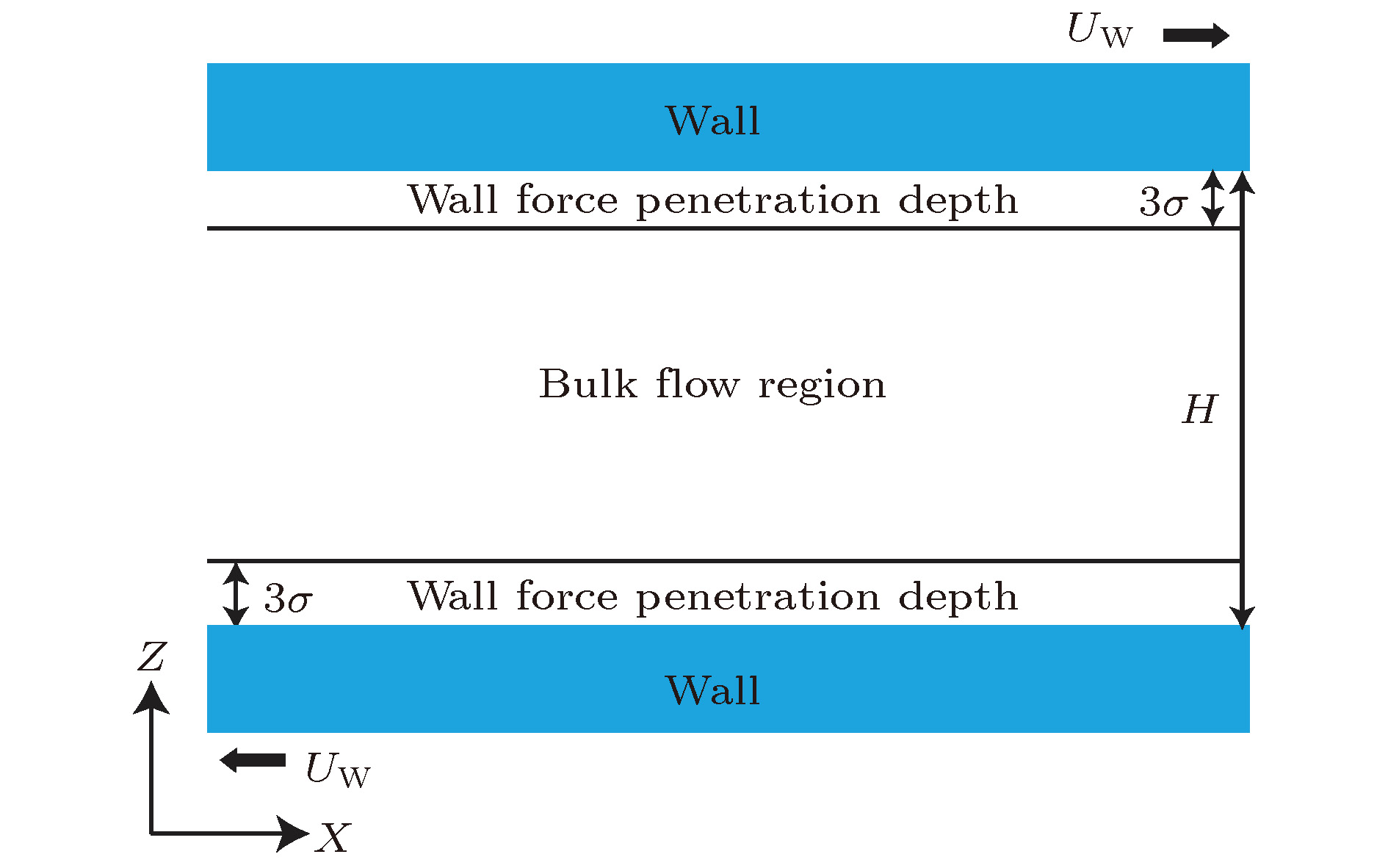
 DownLoad:
DownLoad:


